Series
Geoscience of Climate and Energy 10.
The Alberta Oil Sands: Developing a new regime of environmental management, 2010–20131
http://dx.doi.org/10.12789/geocanj.2013.40.015
1 More than three years ago, and culminating in the summer of 2010, some politicians, environmental groups and members of the general public in the United States were making critical remarks about ‘Canada’s dirty oil.’ In 2009 and again in 2010, David Schindler, FRSC, the respected environmental scientist at the University of Alberta, published papers in the Proceedings of the National Academy of Science with his colleague Erin Kelly (at that time working as a Post-Doctoral Fellow with Schindler) showing that government-sponsored environmental monitoring data had not been correctly identifying the nature or the source of water pollution in the Athabasca River system (Kelly et al. 2009, 2012; see also Miall 2013; Schindler 2013). In fact, until the Kelly et al. papers were published, government and industry sources had been suggesting that most of the pollution in the surface water system was natural in origin.
2 In late September 2010, James Cameron, the Canadian film director (Titanic, Avatar), visited the oil sands to show his concern, and was received respectfully by the Alberta government. This critical attention, both from scientists like Schindler, and from film director Cameron, resulted in widespread alarm at perceived threats to Canada’s reputation and possibly to its export market in oil.
3 Considerable attention has been paid to the environmental management of the Alberta Oil Sands since the summer of 2010. This is summarized in Table 1, and is the subject of the narrative that constitutes this paper.
4 Amongst Schindler’s findings was the discovery that measureable amounts of polyaromatic compounds (PACs), trace metals and other potentially toxic substances were accumulating in the snowpack near the processing and upgrading installations north of Fort McMurray (Kelly et al. 2009, 2010). These substances were being released rapidly into the Athabasca River during the spring melt, at the time fish embryos were developing. Schindler had concluded that the pollutants could only have been derived by aerial discharge from the nearby upgraders. This mode of pollution had been entirely missed by the Regional Aquatic Monitoring Program (RAMP), the independent monitoring organization established in 1997. RAMP had been subject to two major independent peer reviews in 2004, and again in 2010, and both times had been severely criticized for its poor scientific methodology (Schindler 2013). Schindler suggested that RAMP had not found the pollutants detailed in his studies primarily because the detection limits of the contract laboratories employed by RAMP were not sensitive enough. He also pointed out that RAMP had never thought to sample the snowpack. His press conferences, particularly one he held at the Aboriginal community at Fort Chipewyan, received widespread media coverage. A photograph of him holding up a fish with a tumor that had been caught in the Athabasca River seriously implicated oil sands pollution and its possible consequences for the health of the fish on which many of the First Nations communities depend (Fig. 1). However, the actual significance of this type of pollution, in terms of its effects on the health of humans and the aquatic population, remains to be studied in detail.
5 RAMP is one of three so-called ‘multistakeholder’ organizations formed and funded largely by industry to perform the environmental work required by the Alberta government. Governments, First Nations and NGOs are represented in its membership, but a lack of clear scientific leadership has bedeviled the organization since its inception (see Wallace 2013). In contrast to RAMP, the parallel air-quality organization, the Wood Buffalo Environmental Association (WBEA), has gained widespread respect for the high quality of its scientific work and its responsiveness to First Nations concerns (see Percy 2013). A third organization, the Cumulative Environmental Management Association (CEMA) comprises more than 50 members representing Aboriginal, government, non-government organizations and industry. The membership includes First Nations and Métis groups, municipal, provincial and federal governments, environmental advocacy groups, educational institutions and the largest group of pit mining and in situ oil sands operators in the world. CEMA’s role is to produce recommendations and management frameworks pertaining to the cumulative impact of oil sands development
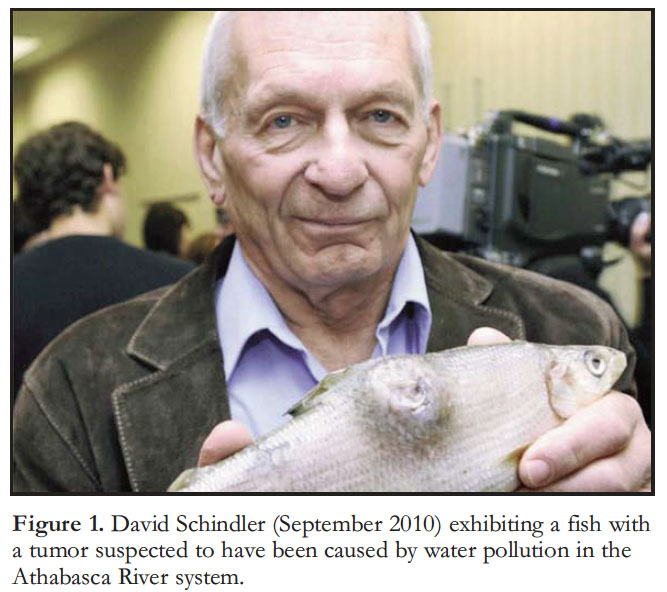 Display large image of Figure 1
Display large image of Figure 16 The heightened attention to the oil sands in 2010 raised public concern to a new level, and both the federal government and the Alberta government realized that action needed to be taken (Table 1). All of this was revisiting history, given that there had been an earlier, and very successful project to manage industrial pollution, the Northern River Basins Study project (NRBS), established in 1991, with managers seconded from all the governments having responsibilities for the air and water of the region, including industry and First Nations representatives (see Wallace 2013). This project had put the best scientists from Environment Canada to work, and had been considered to be doing an excellent job; but the project was quietly abandoned in 1996, owing to declining interest and funding by the federal and provincial governments.
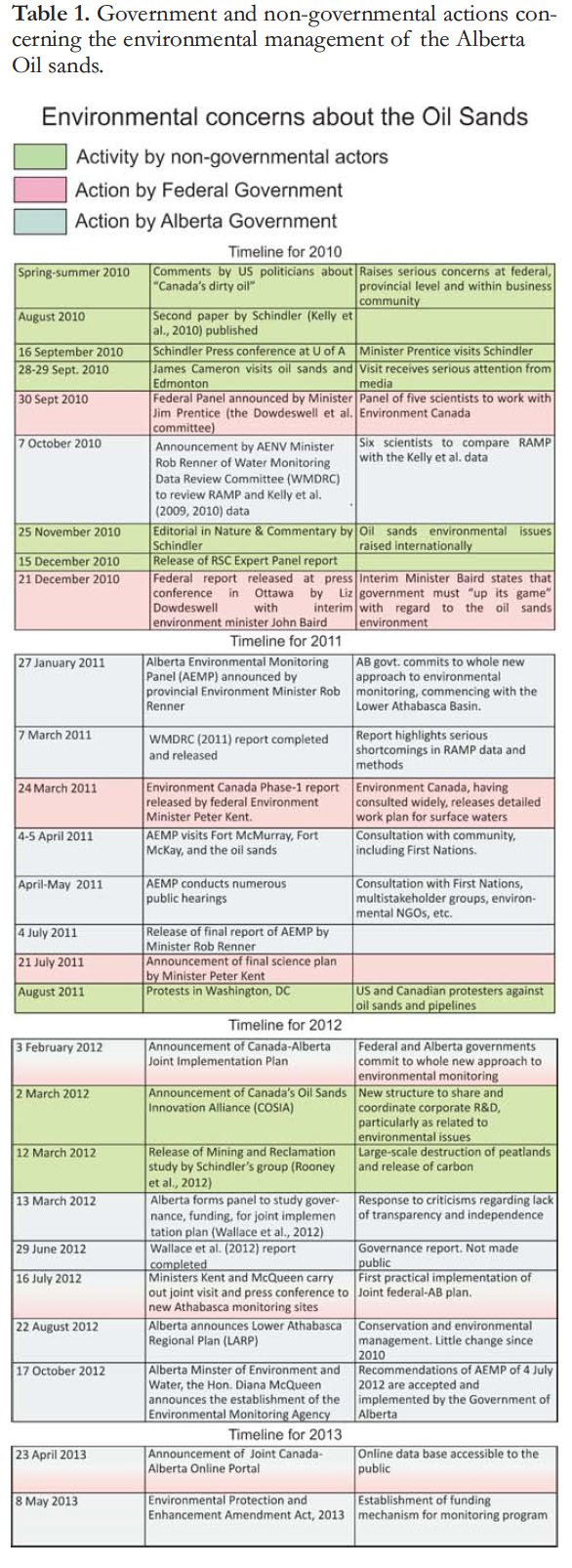 Display large image of Table 1
Display large image of Table 17 A federal Oil Sands Advisory Panel was formed in October 2010. I was one of five scientists who comprised this panel (the others were P. Dillon, J. Smol, J. Rasmussen, and P. Ghoshal), which was chaired by Elisabeth Dowdeswell, the current President of the Council of Canadian Academies. We reported to the then interim Environment Minister John Baird in December. Minister Baird admitted that governments needed to “up their game” with respect to environmental management of the oil sands. He initiated an intensive examination by the senior scientists at Environment Canada of the state of air and water quality environmental science in the region. Meanwhile, the Alberta government established its own panel, the Water Monitoring Data Review Committee (WMDRC) to review the work of RAMP and to compare it with Schindler’s results, to determine why there were such marked discrepancies between the two sets of studies. The WMDRC report was eventually delivered in March 2011 and confirmed everything Schindler had claimed.
8 An Expert Panel on the ‘Environmental and Health Impacts of Canada’s Oil Sands Industry’ had already been established by the Royal Society of Canada (RSC) in October 2009, under the leadership of Steve Hrudy, FRSC, of the University of Alberta, and the final report was released shortly before that of the federal Oil Sands Advisory Panel, in December 2010 (Royal Society of Canada Expert Panel 2010). The Royal Society of Canada Expert Panel findings have been widely reported and discussed within the RSC and in the media, and are not described in detail here. Briefly, the report found that some concerns were justified, others had been overstated, and in general there was a pressing need for more data.
9 The findings of the RSC report formed a very useful support for the recommendations of the federal panel (Environment Canada 2010), that a better scientific framework was required for the monitoring and management of the oil sands environment. The expert panel report also gave the RSC a visibility in Calgary that it had not had before. Although the Calgary petroleum community has been impressed with the report, some environmentalists have complained that the report under-stated some of the environmental impacts of the oil sands developments.
10 With all this as background, the Alberta Environmental Monitoring Panel (AEMP), appointed by Alberta Environment Minister Rob Renner in January 2011, had much to do to come to grips with the magnitude of the environmental problems and to propose solutions. I was honoured to be appointed to this group of twelve citizens representing the scientific, environmental and business communities, and we came together remarkably quickly in our assessment of the problems and the structure of the necessary solution. The panel was co-chaired by Hal Kvisle, a senior oil industry executive (former CEO of TransCanada Pipelines, and currently CEO of Talisman Energy), and Howard Tennant, a former President of the University of Lethbridge. Also on the panel were David Pryce, Operations Vice-President of the Canadian Association of Petroleum Producers (CAPP), Ron Wallace, a highly experienced independent environmental scientist who had consulted on many projects for the governments of Alberta and the Northwest Territories, and had been a member of the Northern River Basins Study Board of the 1990s (Wallace 2013). Rounding out a subgroup of scientists on the panel were Greg Taylor (a biologist and Dean of Science at University of Alberta), Warren Kindzierski (School of Public Health , University of Alberta), Joe Rasmussen (aquatic biologist, University of Leth-bridge) and Howard Wheater (Director, Global Institute for Water Security, University of Saskatchewan). The other members of the panel were Joe Doucet (School of Business, University of Alberta, and David Williams (an environmental lawyer). Visits were made by panel members to Fort McMurray, to the oil sands industrial sites, and to the First Nations communities at Fort MacKay and Fort Chipewyan. Public hearings were held and much advice received.
11 In the midst of this process, on 8 th April 2011, David Schindler and I were involved in a special forum at the Munk School of Global Affairs at the University of Toronto organized by Adele Hurley, Director of the Program in Water Studies at the School. The title of the event was ‘Under new management? Oil Sands development as if the environment mattered.’ In preparation for this event, Schindler, Hurley and I put together a discussion paper highlighting the many and varied environmental issues, and the event, which was widely webcast, gave us the chance to disseminate the environmental concerns in a balanced way to a widespread audience.
12 The conclusion to all of these studies and discussion groups is that only an independent, science-based monitoring authority, at arms-length from government and industry, could establish the necessary credibility in gathering data, carrying out analyses and making recommendations regarding local and long-term, cumulative environmental effects (Fig. 2). A formal process termed MER: ‘monitoring, evaluation and reporting,’ needs to be initiated in the oil sands area and the scientists need to be able to consult freely and widely, for example by bringing in specialists to assist with particular projects or to work on experimental design as needed (Fig. 3). The AEMP recommended a new Environmental Monitoring Commission to carry out this work. Administration of the environmental regulations in Alberta would remain the responsibility of a separate board, the idea being that all parties would be better informed with the essential environmental information if it came from the proposed new agency. Until recently, regulation of the petroleum industry was the responsibility of the Energy Resources Conservation Board (ERCB), but under Alberta Bill 2 the ERCB was abolished and, in December 2010, a new regulation system, the Alberta Energy Regulator (AER) was established. The new oil sands monitoring agency is to be independent of AER.
13 The final AEMP report containing the recommendations for the new monitoring agency was submitted to the government of Alberta at the end of June and released by the Minister a few days later, on July 5th 2011. The nature of the experimental method and the need for independent inquiry were emphasized (Fig. 3), and there were detailed recommendations regarding the structure of the proposed commission and the need for full, First Nations participation.
14 Meanwhile scientists from Environment Canada had been working with their counterparts in Alberta, Saskatchewan and the Northwest Territories to develop a fully-fledged science plan to do this work. The completed plan was announced by then Environment Minister, Peter Kent, on 21 st July 2011. At the time it was openly speculated by the Minister that implementation of the plan could cost in the range of $50 million per year (CBC News; http://www.cbc.ca/news/technology/expanded-oilsands-monitoring-planned-1.986212) (up from the $20m he had suggested in March, 2011; see Wallace 2013).
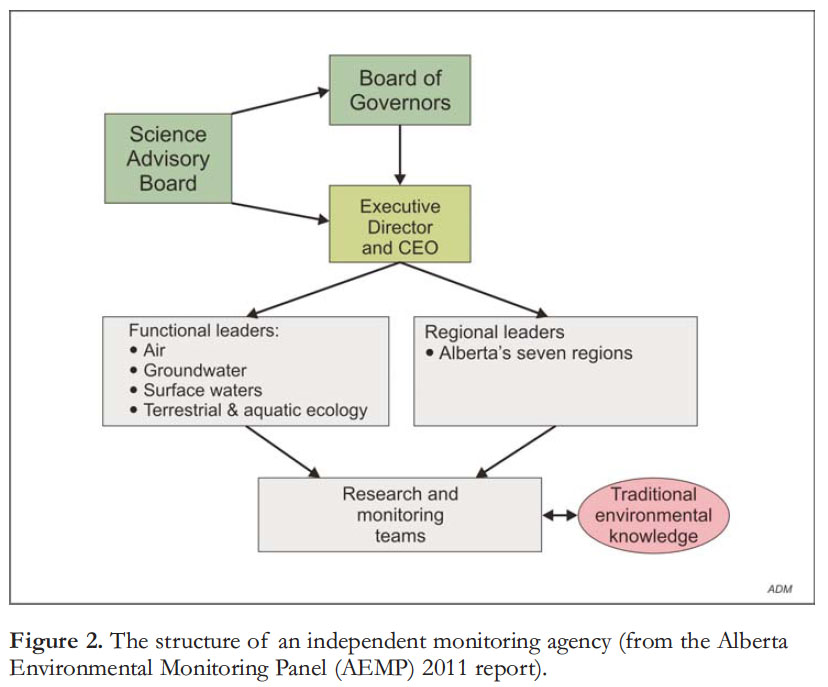 Display large image of Figure 2
Display large image of Figure 215 The AEMP report (AEMP 2011; see also Wallace 2013) contained a discussion of the need for “world-class science” and an explanation of what this term means.
16 A major piece of the puzzle was to figure out how the federal and the Alberta governments could bring their ideas, their scientists, and their responsibilities together, to make this project work efficiently (Fig. 4). While Alberta owns the resource, and has the responsibility for managing oil sands developments, it has been felt that it has little capacity to carry out credible scientific work on its own behalf. However, the federal government has intersecting responsibilities to manage transboundary pollution, to ensure the health of First Nations Communities, and to act as environmental stewards for federal lands, such as Wood Buffalo National Park, and the health of fish-eries everywhere. And Environment Canada, despite years of cutbacks, still retains world-class laboratories and institutions fully capable of carrying out the necessary scientific work. This is a jurisdictional challenge. However, both the former Alberta Minister Rob Renner and federal Minister Peter Kent were on record as promising action in this area.
17 Alberta Premier Ed Stelmach had indicated his intent to resign as Premier in May 2011, and a leadership convention was held in September. The new administration in Alberta, led by Premier Alison Redford and Minister of Environment and Water, Diana McQueen, who took over in October 2011, did not immediately respond officially to the AEMP recommendations for an independent Environmental Monitoring Commission. However, remarks made by the latter at press conferences in early November 2011 suggested that they were beginning to move in the right direction. Money should certainly not be the issue. Industry is already spending tens of millions of dollars on environmental monitoring and has indicated that they would be happy to see these funds spent more effectively. Given the level of investment in oil sands development, which could reach $10 billion a year over the next decade, industry funding should not be a problem.
18 In early December 2011, I used a long-standing commitment to the Canadian Society of Petroleum Geologists to present a noon luncheon address to the membership on “Environmental Management of the Alberta Oil Sands: Recent Federal and Provincial Initiatives.” About 1000 members usually attend these events, and so it was an important opportunity to brief the Calgary petroleum community and to enlist their support. As was reported in Calgary’s Daily Oil Bulletin the next day, I said “Alberta’s oil sands have some very big problems that need to be addressed and none of the solutions that have been tried to date have worked, … Certainly this has left Alberta, and Canada, it has to be said, in a very vulnerable position vis-a-vis international relations — the importance of building an industry that has a healthy ability to access customers in export markets, pipelines and everything else that’s important to the industry — so it is really very, very important that we make the right things happen.”
19 My sense has long been that the professional and technical community comprising the petroleum industry in Calgary would welcome the establishment of a credible environmental management organization, as would the executives and senior managers. Many are concerned about the damage that is being done to Canada’s reputation by the perception of mismanagement that has characterized oil sands development up to now (e.g. see editorial in Nature, 25 th November 2010: http://dx.doi.org/10.1038/468499a). Any idea that this community could be grouped under the heading of ‘Big Oil’ as opposing sensible regulation of their industry is quite false, as demonstrated on 2nd March 2012, when the formation of a new kind of industry association was announced. Canada’s Oil Sands Industry Alliance (COSIA) (quoting from their website www.cosia.ca) has set out to act as:
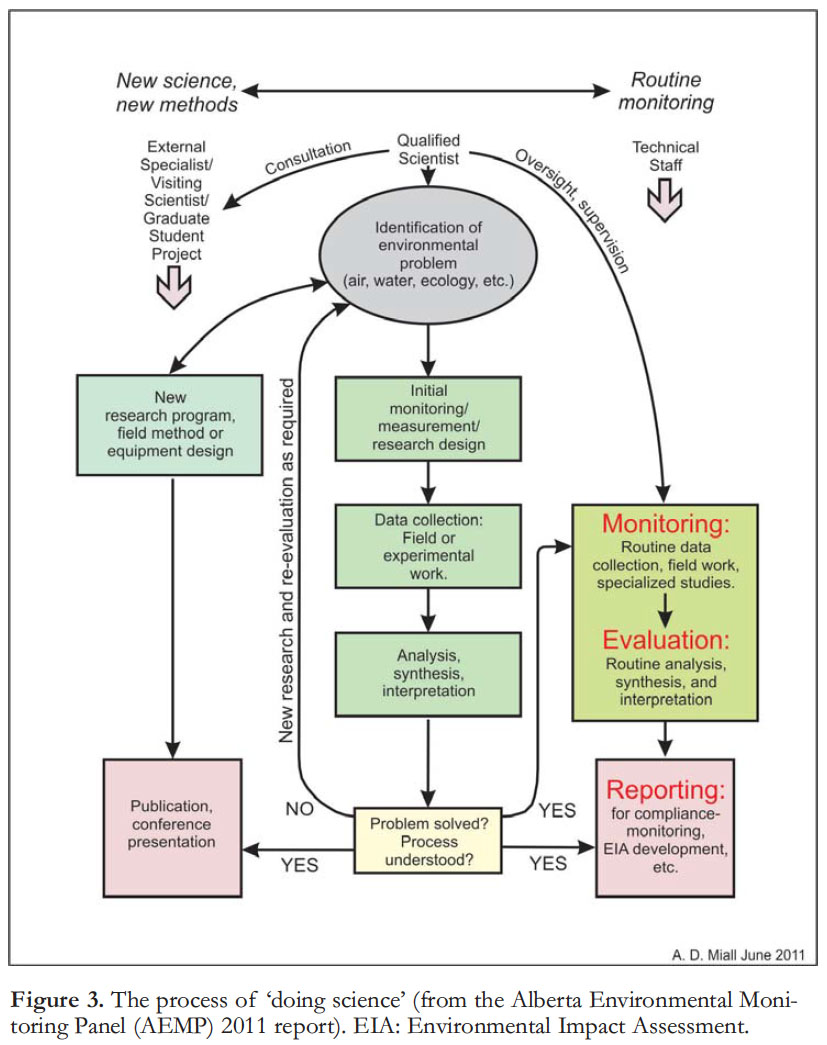 Display large image of Figure 3
Display large image of Figure 320 The COSIA organization joins the twelve largest oil sands operators in binding agreements to share resources and research, including patents, on environmental management. The announcement was attended by the CEOs of all twelve companies, and the CEO of COSIA is Dr. Dan Wicklum, a highly respected and experienced scientist who left his post as Director of the Water Science Technology Directorate at Environment Canada to take on this important new task.
21 Given the opposition that is currently being expressed to the two major pipeline proposals for the export of oil sands crude (the Keystone and Northern Gateway projects), the industry and the Alberta government have a very long way to go to generate a consensus and a ‘social licence’ that oil sands development is the right way to go. Even if we don’t need the resource now, we will in the near future, and so there is everything to be gained by proper environmental monitoring and management of the many extraction projects that are now underway.
22 At the end of January 2012, it appeared that everything was finally coming together for a new regime of environmental management. The scientists, who had taken part in the various panel processes and in the development of the Environment Canada science plan, were invited to take part in a teleconference briefing of a new Joint Canada–Alberta Implementation Plan for Oil Sands Monitoring presented jointly by officials of Alberta Environment and Sustainable Resource Development, and Environment Canada. The scientists involved in the briefing included David Schindler, Steve Hrudy, John Smol, Joe Rasmussen, Ron Wallace, and myself, along with half a dozen other individuals, and a large team from each of the two governments. This was a technical briefing, and it laid out for us a truly first class science program based on the planning work done by Environment Canada. A new open, public website was to be established for the program, and all data were to be released. The public announcement of the report was made jointly by Ministers Kent and McQueen a few days later, on February 3rd.
23 However, the conference call did not at all go the way Environment Canada officials had expected. Everybody thought that the science plan was excellent, but the questions were all about management. Who was going to be in charge? When we were told that the plan was to be jointly administered by two assistant deputy ministers, one from Environment Canada and one from Alberta Environment, most of the participants in the discussion expressed concern. The officials managing the briefing thought that establishing a program that would release all the raw data would be enough. However, there is an important difference between the release of raw data and the ability of a government scientist to carry out an independent analysis and offer opinions to the public. It was clear that the scientists involved in the briefing were not convinced that the latter would become part of the plan.
24 In response, the Alberta government was persuaded to establish another study group to explore the issue of governance, led by Howard Tennant, Ron Wallace, Greg Taylor and Hal Kvisle. Everyone paused for a provincial election on April 23rd, 2012, but the result was that, essentially, all the key players came back to their old jobs the next day, and picked up the files and carried on. Minister McQueen became the minister in charge of a revamped Ministry of Environment and Sustainable Resource Development.
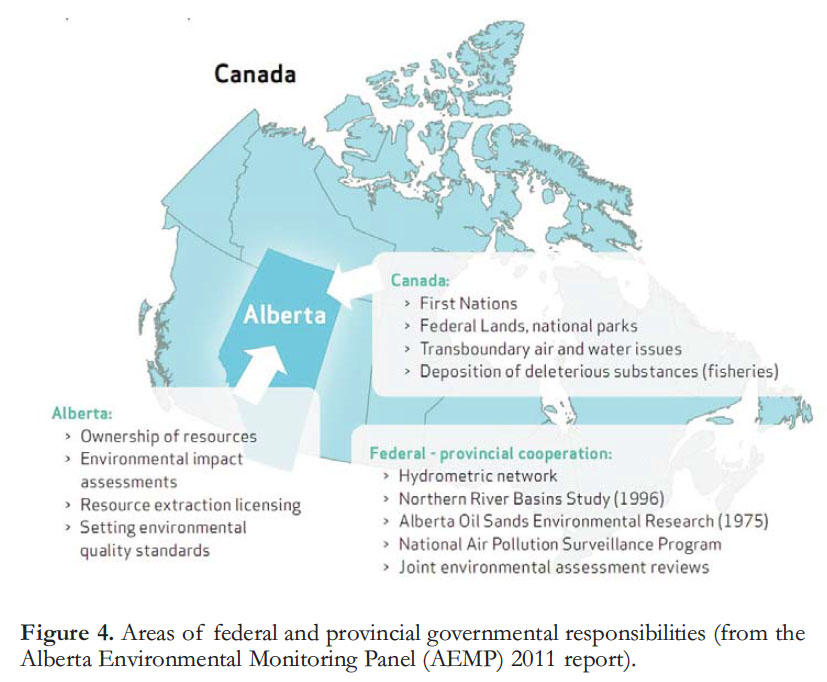 Display large image of Figure 4
Display large image of Figure 425 The journalist, William Mars-den (of the Montreal Gazette), wrote an article in early February (2012) that was widely published in the Postmedia group of newspapers with the headline “Scientists win historic battle over oil sands monitoring,” (http://business.financial-post.com/2012/02/06/scientists-win-historic-battle-over-oil-sands-monitoring/) highlighting the formation of the new panel to do further work on this issue of governance. This was after the announcement of the Joint Implementation Plan, and his article included some indications of the scientists’ problems with it. For some months this headline seemed premature and over-optimistic, but discussions continued. On 22nd August the Alberta government introduced its Lower Athabasca Regional Plan (LARP) which, while calling for increased programs of environmental monitoring, did not indicate acceptance of the concept of an independent monitoring agency.
26 However, eventually the Alberta government came through. On 17th October 2012, Alberta Minister of Environment and Sustainable Resource Development, the Hon. Diana McQueen, released the Alberta Environmental Monitoring Working Group governance report that had been submitted in late June (AEMWG 2012), and announced that she was accepting the recommendation for the establishment of an independent environmental monitoring agency. As the first step, she announced the establishment of the Alberta Environmental Monitoring Management Board, to begin the planning work. There is no question that the very thorough and detailed governance report, supplemented by expressions of support from many interested parties including the oil sands industry itself, in the end created the momentum for this important step forward.
27 Federal Environment Minister, the Hon. Peter Kent, was quoted in the Globe and Mail the next day saying he did not think such a body was necessary, and one of the outstanding issues still to be resolved, was how the new Alberta agency was to interact with Environment Canada. However, it would appear that with the action by the Government of Alberta, the concept of ‘evidence-based policy formulation’ had taken a big step forward.
28 The Canadian Science Policy Conference held in Calgary in November 2012 included many presentations and debates on energy and environmental issues, and a theme that went through the entire program was the recognition of the need for interdisciplinary work and for all sectors — industry, government and the academic sector, to share ideas and information and to cooperate on a broad, long-term basis. The formation of consortia, such as COSIA, to share ideas, new products and processes, even patents, is a relatively new concept for what has traditionally been a very guarded and competitive industry. However, the oil sands developments need a different approach, and there have already been several multi-company partnerships with more limited objectives; for example to work on the tailings problem. There seems to be a new mood that the ‘social licence’ to exploit the vast new reserves of oil sands, tight oil and shale gas, requires a greater degree of openness with the public and a sense that all sectors of society need to be pulling together to make the right things happen. Behind the scenes, a considerable amount of practical research has been underway for many years within the corporate sector, and at institutions, such as the University of Alberta and the University of Calgary, to improve oil sands processing methods, introduce efficiencies, reduce energy and water use, and minimize environmental damage. Very little of this is known, however, by the general public. An editorial that had appeared in the international science journal Nature in November 2010, criticizing Canada for losing its way as a good environmental steward, rankles in the Calgary professional community, and if the formation of COSIA can help to correct this image it will have had its first success.
29 The new Alberta Environmental Monitoring Management Board has a lot of work to do (R. Wallace, author of the article preceding this one, is Vice-Chairman of this Board). Not only must the science be excellent and free from potential influence by government or industry, but it must be seen to be so. Such a structure will also facilitate a greater role for the First Nations, not only in taking part in the administration of the work, but in participating through the integration of Traditional Environmental Knowledge into the observational framework. Amongst the recommendations of AEMP (2011) was the formation of a Science Advisory Board, to provide periodic independent oversight of the monitoring program. The nature of the cooperation with the federal government remained to be completely sorted out. The next step in this direction was the announcement by federal Environment Minister Peter Kent, 22nd April 2013, of the establishment of a joint Alberta–Canada ‘Online Portal for Accessing Oil Sands Environmental Monitoring Data and Information. On May 8th the Alberta Legislature passed Bill 21, The “Environmental Protection and Enhancement Amendment Act, 2013,” which established a funding mechanism for up to $50 million per year to support the monitoring program. On 26th June, 2012, the final details of the Joint Canada–Alberta Implementation Plan for Oil Sands Monitoring were announced by the governments of Alberta and Canada. A website has been established at http://www.jointoilsandsmonitoring.ca.
30 It is not easy to persuade governments to move off their longstanding preference to keep everything in-house. Independent agencies mean a loss of message control and the potential for surprises for the Minister. In this case, the issue came alive initially because of intense public pressure cresting at precisely the same time as the publication of a key article by David Schindler’s group in the summer of 2010. It was kept alive because of the continuing efforts of panel members and other scientists to remind the two levels of government of their responsibilities, and also because the industry itself, in perhaps the most surprising move of all, came together collectively to indicate that this was something that needed to be done. World-class science needs independence, and it now appears that the oil sands will get this kind of attention officially, with government compliance. This is an essential precondition for the nurturing of the concept of evidence-based policy formulation, and one that is increasingly difficult to meet in an era of skepticism about the scientific enterprise. But in this case it appears that we will satisfy this condition, one that should characterize the work of all science-based government departments.
31 After the flurry of public concern in the summer of 2010, public interest in the environment of the oil sands has ceased to be a topic that receives much attention in the media. Attention has shifted to pipeline proposals. However, a surface leak of bitumen from the Canadian Natural Resources subsurface project at Cold Lake in the Spring of 2013 indicates that there is a continuing need for environmental management and oversight. Meanwhile, the government of Alberta appears to be slowly working its way towards a full implementation of the changes it initiated with the establishment of the AEMP in early 2011.
Appreciation is extended to my colleagues on the AEMP for the engrossing and invigorating discussions that led to our final report. Particular thanks are extended to Ron Wallace for his contributions to the development of this paper. C. E. Miall carried out an essential critical reading and editing of the manuscript.